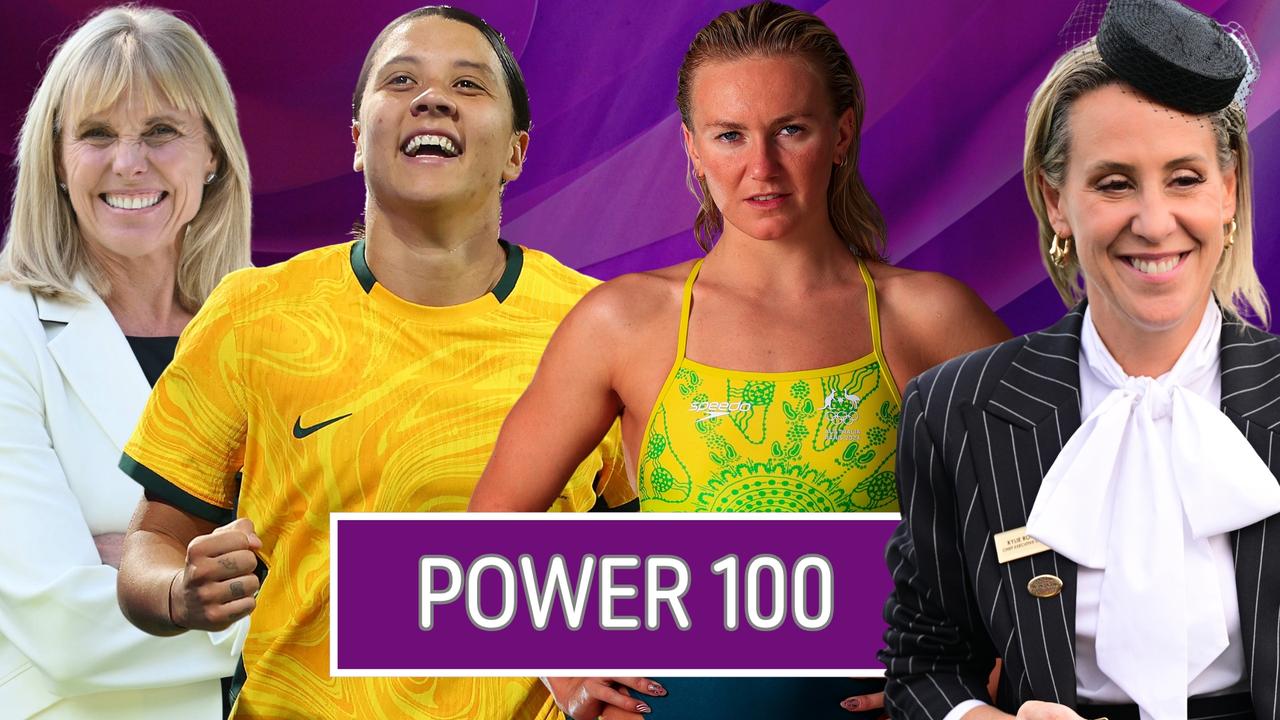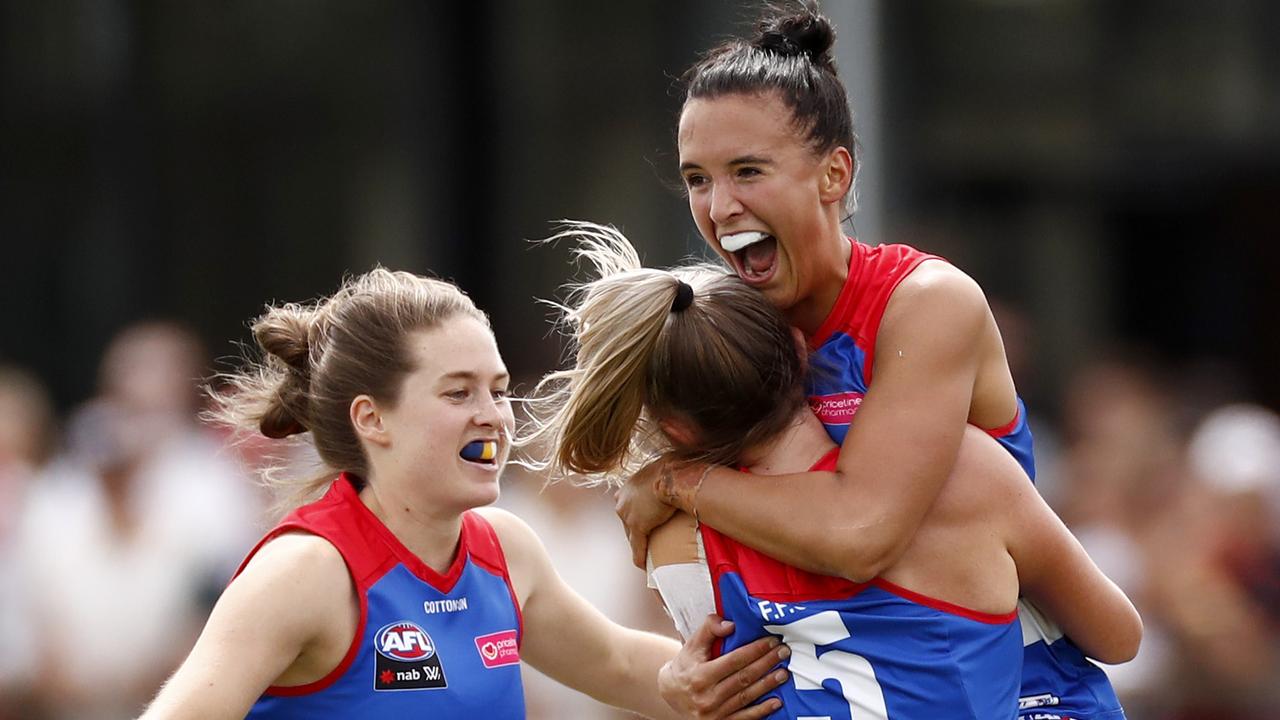AFLW pay equality: Coach Daniel Harford says women’s game cannot rush more clubs, full-time pay
Carlton coach and radio commentator Daniel Harford tells Scott Gullan the women’s game continues to rise, but it still cannot rush more clubs, longer seasons and full-time pay.
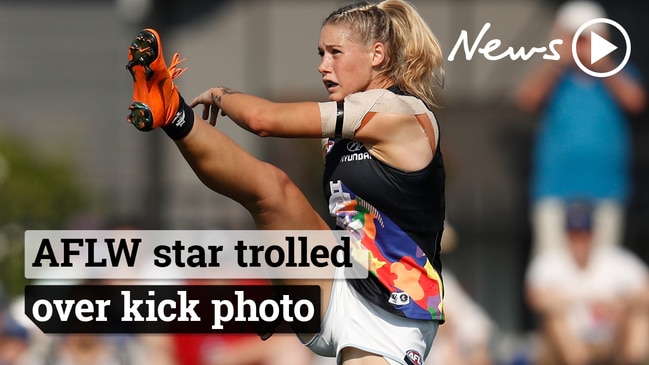
AFLW
Don't miss out on the headlines from AFLW. Followed categories will be added to My News.
The women’s game is on the rise, but as Carlton coach Daniel Harford tells Scott Gullan, it’s a long way off going fully professional.
Watch every match of the 2021 NAB AFLW Competition LIVE on Kayo. New to Kayo? Try 14-Days Free Now >>
SCOTT GULLAN: We‘re five seasons into the AFLW. What is your take on the state of the women’s game?
DANIEL HARFORD: “I think it is in a really healthy place from where it came from to where it is now. You‘ve got pathway programs in place where kids are coming through and having great impact straight away. Clubs have worked out, particularly established ones, what it is to their business and the resources they need to operate with and under. It is getting to a point where the expectations from people outside, and maybe even the competition, is that it does continue to accelerate at this rapid rate and I’m not sure you can do that in a part-time program with part-time staff as well. That is one of the biggest issues that people don’t talk about, the demands on the staff is increasing significantly. It’s their part-time job as well so whether they can commit to help it grow long term or you get people coming and going every couple of years which creates a bit of instability. I think that is one of the biggest challenges at the moment, but overall it’s super healthy.
SG: Where do you sit with the professional debate? Can the women be full-time footballers like the men?
DH: They certainly can, it‘s whether there is an appetite for that to happen and whether or not there are resources and funding to make that happen. You’re not just buying 420 players, you’re buying 30 staff at each club so you’ve got 750 people to employ in a full-time capacity. They would all have to give up their other current employment to do that and whether they can feasibly do that would be something you’d have to ask them as well. I think it is a bit off, just for that alone. It is going to be a huge cost and whether they can find that, have that, invest that hoping to get it back at some stage, I don’t know.
SG: Are they paid enough now to be able to be professional?
DH: There might be a couple who can use their package to be full-time with jobs and cars that come with some packages, I‘m sure there are a couple of players in the competition who could do it. Until you also got all 18 teams in, you can’t go full-time. You can’t be having teams — the four new clubs come in two or three years time — and be part-time whereas everyone else is full-time, that doesn’t work. You bastardise your competition if you do that so until there are 18 teams I don’t think the conversation about full-time will actually happen anyway.
SG: Overall are AFLW players paid well enough?
DH: That‘s a good question, probably at the bottom end no. The effort and time that goes into it, the hourly rate wouldn’t be much at all. Probably not is the short answer. The top end is pretty good, the medium would be manageable, but again, it is a significant commitment to be a part of a program at all levels as a player, staffer or administrator.
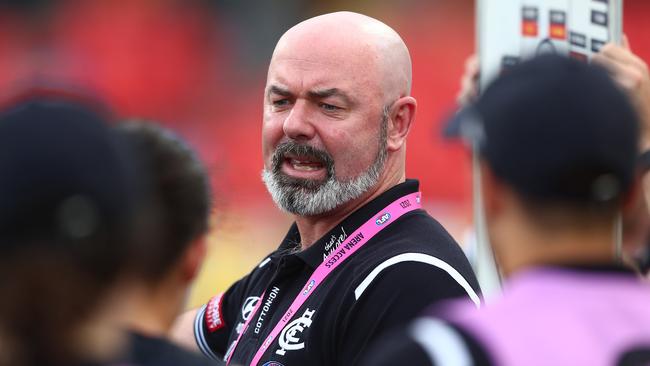
GET THE MIXTURE RIGHT: DISCREPANCY TOO GREAT
SG: When should the new teams come into the competition?
DH: My take is it is too early still. The gulf between the best teams and the developing teams is quite significant still if you look at the eight original clubs and the expansion teams in the last couple of years and the difference in competitive capabilities just on those stats alone, that information alone, that is a challenge. Bringing four more teams in and then you‘re ripping the heart out of other established teams and then trying to find next generation talent to come in and influence straight away to the point where it is going to be competitive week in week out as the season gets longer, that is a real challenge for the competition. There are a couple of clubs who are desperate to get in because I say they do make your clubs better when you’ve got a women’s program as part of your football operation. I just think what we have seen in the last couple of years with the expansion, we can’t have a competition that has a discrepancy as great as it has been in recent years.
SG: What about rule changes? The men‘s game is tinkering, how is the state of the women’s matches?
DH: The actual game itself is pretty well managed. We don’t do all the stuff the men do because funnily enough we’re not men and we don’t need to do that. The women’s competition is its own competition, it is the same sport but it‘s a different competition. I think it is part of its charm and part of its appeal I must admit and I don’t think we need to mess around too much with it. I think it is more pure raw form of footy bit more old-school footy compared to the constant tweaking that seems to be going on in the men’s competition I think a lot of people warm to that significantly.

SG: Sadly we seem to having a serious knee injury in the AFLW almost every week, are injuries a major concern?
DH: My understanding is physiologically and biomechanically female footballers are 10 times more likely to do their knees. That is just something in their make-up, clearly nothing you can do about that. I think the earlier players start playing the more musculature and condition they have to footballing movements through their formative years, teenage years the better. Then once they get to the AFLW with great strength and conditioning programs and fitness regimes hopefully there is a reduction in the number of ACLs I don’t know if that is feasible or possible but it does seem to make a bit of sense to me if I’m putting it on a white board. It is one of those things with combat women’s sports, a lot of knees happen and a lot of knees happen in netball and hockey. It is not to do with the sport, more to do with biological make-up.
SG: The critics seemed to have been quietened more this season. Do you sense that?
DH: My personal view is that there is a much higher level of engagement with the AFLW and whether or not it’s draining out a lot of the negativity, I’m not quite sure. There is much more positive than negative relationship from footy fans and sports fans for the women’s competition certainly now compared to two or three years ago, no doubt about that.

DOUBLE-HEADERS DEFINITELY HAVE POTENTIAL
SG: The timing of the season is a major issue with the finals lost in the start of the men’s season. What is the best solution?
DH: It is a bit of a catch 22, if you have your own season and end up having the full 17 weeker or full 22 weeks, you have to start in October, that is your window to play through to March and to have your clear air. Perhaps that’s an ideal scenario for headquarters to own the calendar with footy every week of the year but I don’t know. It’s a challenging period of the year for conditions and also in terms of engagement from fans and employers, it’s the time when people start to get down time and have time off and rest around those periods so you’re messing with the whole cycle of life if you take over that full summer period.
I don’t mind having double-headers with the boys, I think it is a great opportunity to advance the game, to get promotion and awareness of the game and get fans engaged with both programs within their footy clubs. I think a lot of fans if there were double-header options would embrace that opportunity to get to the footy early like they used to and watch the girls play first or boys play first.
SG: You were a very successful coach before you joined the AFLW ranks. What were the main challenges you faced?
DH: The biggest one for me was the knowledge gap, it’s not that the girls didn’t want to learn or have the capacity to, it was just the amount of time that had been invested in their knowledge and teaching of the game. That was the biggest one for me, just being able to bridge that gap and try to close that as well as you can to what blokes have known since they were seven years old playing footy. This a relatively new phenomenon for a large percentage and while the pathway stuff has accelerated now, when I first stepped in there was a dearth of game sense, style, terminology which we tried to fast track as much as possible.
And then you have got men and women and the way they deal with success, failure and challenges. We‘re different and that has been one of the real eye-openers for me and one of joys for me to be able to see how different people operate in different circumstances.
SG: Would elite AFLW players be able to play at a lower level men‘s competition?
DH: It’s a good question. I imagine the real elites could really have an impact at senior level somewhere, physically obviously they are very different which is a challenge in itself but it would be interesting to see.

MOMENT OF OPPORTUNITY THAT WENT BEGGING
SG: You just missed the finals this season. What happened at Carlton?
DH: We didn’t manage our moments, there were a couple of key moments and that was the season for us. We were all over the shop at times during games and couldn’t find our consistent continual rhythm. It was basically 12 minutes of footy — seven minutes against the Pies, four minutes against the Dogs and one minute against Freo; that’s the summary of our season.
SG: Whast is your future in the women’s game?
DH: Until such time that I get told I’m not, I am certainly keen to get back and get into next year quickly. I’m not overly rapt how it went for us this year and I’ll be there next year until such time that I’m told otherwise.
SG: Will Tayla Harris be at Carlton next year?
DH: Tayla has got a lot to offer the Carlton Football Club, no doubt about that. She is out of contract so I’m sure there will be other teams knocking on the door for Tayla because she is a pretty hot commodity. We’ll see what happenes with Tayla but we’d like her to be there.
SG: Who wins this year‘s flag?
DH: I think it is a fantastic top six. Melbourne‘s last month has been unbelievable but Adelaide and Brisbane are the pole sitters at the moment. I think Adelaide’s experience at that time of the year, even though Brisbane’s got a few in that boat too, I think the Crows experience that time of year if they get through to Grand Final I think they will be tough to beat at home.
SG: Who are the top three players in the competition?
DH: Brianna Davey, Kiara Bowers and Jasmine Garner.
SG: So Daniel when will you be taking the step and taking over an AFL men’s program?
DH: I am very happy with my life balance at the moment. I don’t think men’s footy is in my future.
AFL’S CHANCE TO END ITS EXPLOITATION
— Prue Gilbert
“That is where the power, opportunity and choice come from — when you have money. Money equals opportunity. There is no question.” Billie Jean King
It’s been a stellar season for the AFLW, with female athletes performing both on and off the field, entertaining fans and delivering a product worthy of sponsorship and broadcast rights.
If professional sport is a microcosm of society then now represents a Kodak moment for the AFL. While social change — gender equality in particular — can feel glacial, the current groundswell from women demanding action against gender inequality makes it hard to believe it was only six years ago that the AFL held the position of being able to attract players from many other codes. And with none of the codes then ready to acknowledge the true value women bring to sport, it was easier to dangle salary rises as nothing more than a symbol of hope than make firm commitments to equality.
In 2019, the AFL again resisted a unique opportunity to lead on gender equality in sport.
Coming up against 30 per cent of the players, the AFL refused to engage on principles of equity and fairness during the last CBA negotiation. Rather, they opted for a 10-game season during which female players earn between $16,000 and $30,000 each; the league gaslighting players on income with a narrative that they need to make the game more entertaining to grow it.
How times have changed and arguments against pay equity fast become old.

Rhetoric that the game “just isn’t entertaining enough” with the knock on effect that “it won’t attract sponsorship and broadcasting” deals are now myths. In its place we now see a war for talent in women’s sport, and sponsors representing some of the biggest Australian brands, from BHP to Cotton On.
Yet when it comes to respect for women and equal pay for equal work, the AFL lags behind its competitors. It needs to be said that equal rights for others does not mean fewer rights for you. It’s not a pie.
More than 50 years after the equal pay principles were enshrined, data released this week by the Workplace Gender Equality Agency reveals it will be at least 25 years before we close the gender pay gap. And while I expect the Respect@Work Report’s recommended changes to the Sex Discrimination Act imposing a positive duty on workplaces to prevent sexual harassment will indirectly require workplaces to finally become accountable for pay equity, I suspect the AFL’s business case can’t wait for legislation to take action.

Pay equity in sport is now a burning platform. Over the past two years, we’ve seen Socceroos and Matildas negotiate pay deals that recognise female players as professionals, and respect them by paying them not just a living wage — but an equitable wage. A wage reflective of their professional sporting status that also pays them dignity and respect.
More than that, in challenging gender inequality in all its forms, the AFL has a significant opportunity to send a powerful message to the entire community on the standards it expects when it comes to the treatment of women. Brave leadership would see Richard Goyder and Gill McLachlan insert themselves into a national conversation on respect, and in addressing pay inequality, role model accountability.
Sport is integral to Australia’s national identity and it has huge potential to influence Australian culture and shape behavioural norms. If the Adam Goodes’ saga taught us anything it’s that sport is an incredible mirror that we as Australians can hold up to see when we are falling short of the expectations we have of ourselves.
The big vision for AFLW? A truly world-class game, where the pie is expanded, rather than divided. A game where the leadership and culture is spoken about in the same way our cricket and soccer teams are. A code where we do away with gendered stereotypes for administrators and players.

Stereotypes that hold men to an unrealistic standard, where mental health and wellbeing are prioritised and players are both intrinsically and extrinsically motivated to realise their potential. A code where all people feel safe and welcome, regardless of race, gender, religion or ability.
The AFL reimagined requires a shift in leadership mindset. And a willingness to engage in tough choices and decisions to disrupt the status quo and rebuild its foundations on a system of equity. Right now these questions are being asked at all levels of society and the AFL is not immune.
The AFL also needs to meet other AFLW player demands on season duration to grow the game. Wedged between the Australian Open and the AFL’s men’s competition, even the Prime Minister was remiss of the fact that the AFLW had been in play for eight weeks when he closed his press conference this week — on sexual misconduct no less — with “I’m just glad footy’s back on, it helps everybody.”
Women comprise 50 per cent of VFL and AFL audiences and the AFLW is the fastest corridor of growth for the AFL. Yet its investment in AFLW pales in comparison to even the introduction of an AFL men’s team. Set alongside the events of the past month in our nation’s capital and the visceral reaction of Australian women, it makes it very apparent that the AFL can wait no longer to pay its talent equitably and treat them with the respect they are entitled to — on and off the field. Australian women will no longer forgive male leaders disrespecting women. Calling AFLW players “professional” but restricting them from earning a living in the profession constitutes disrespect.
The groundswell of recent weeks cannot be ignored by Goyder and his fellow AFL commissioners. For the AFL to keep repeating that “the female players understand that we are on a journey” is nothing short of exploitation and an abuse of power over a playing group so passionate to finally do what they’ve always dreamt of.
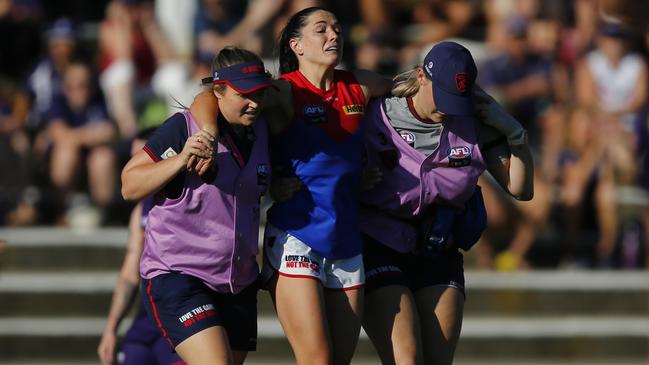
At the heart of its culture and values the AFL can remind us all, through actions, not just words, that while not all disrespect towards women will end in violence, all violence towards women begins with disrespect.
This is a time of reckoning for our nation, and an opportunity for the AFL to be a significant part of the change we need. Standing on the shoulders of the courageous female players, administrators and commissioners who went first, AFL leadership is uniquely placed to hear that change. We should see female representation at the AFL Commission, on the executive team, within the club presidents and directors. Let’s stand beside them, too, as they find their voice and represent our collective roar for equal pay and equal play.
#Enoughisenough
* Prue Gilbert is the CEO of Grace Papers, a gender equality advocate and a former member of the AFL Players’ Association women’s advisory group.
WAGE PARITY COULD BE ‘20 YEARS AWAY’
The AFL — Australia’s richest code — has been accused of “lagging behind the world” in the fight for fair pay in women’s sport.
Sex discrimination experts say the AFL has engineered a restricted AFLW season that allows it to avoid paying “professional wages” to its female players.
The AFLW fixture is limited to nine home-and-away games, plus finals, and club contact outside match day is restricted to 10 hours per week.
Prue Gilbert — a former member of the AFL Players’ Association women’s advisory group — said the time had come for AFL commission chairman Richard Goyder and league chief executive Gillon McLachlan to show “brave leadership” and “insert themselves into a national conversation on respect, pay inequality and role model accountability”.
“The groundswell of recent weeks cannot be ignored by Goyder and his AFL commissioners,” Gilbert said.

“For the AFL to keep repeating the quote that ‘the female players understand that we are on a journey’ is nothing short of exploitation and an abuse of power over a playing group so passionate to finally do what they’ve always dreamed of.”
Victorian businesswoman Susan Alberti — the trailblazer of women’s footy — told News Corp she believed that many AFLW players were “too afraid to speak out” about the competition’s inferior pay and work conditions.
The former Western Bulldogs vice-president, who championed the creation of a stand-alone women’s league, said a large number of players still “feel like they are more of an afterthought” in the AFLW’s fifth year.
“The younger players are feeling privileged but unworthy,” Alberti said.
“Eventually they want their own season that runs in conjunction with the men’s competition.
“They have a four-month lay off and all of a sudden, ‘bang’ they are into the pre-season and ‘bang’ into injuries. It’s not giving them a good chance of being fit and healthy and playing to the best of their ability.
“The women are always feeling like they are unworthy of recognition and of filling pay gaps. You’ve got to drag it out of them, they are too scared to speak out.”
But in a statement to News Corp, the AFL said it was committed to growing the AFLW “into a sustainable elite competition”.
“The end goal is to have 18 teams giving more women more opportunity to be paid to play elite sport,” the spokesman said.
“Season 2022 will see a pay increase of 16 per cent for players contracts and the home-and-away season will increase from nine to 10 rounds, plus finals.
“We are in the middle of a three-year CBA with the playing group and currently have 420 players on playing contracts, the most of any elite women’s sport in the country.
“After only five seasons the league is evolving and the progress across the competition from the on-field to the off-field continues to be remarkable and inspiring.
“It has established its own stand-alone audience, we are thankful for our broadcaster and corporate partners and all the fans who for the first time this season have purchased tickets to attend games — many of which have sold out.”
This weekend’s AFLW finals matches are being played at suburban grounds Casey Fields and Victoria Park, while men’s games are scheduled for the MCG and Marvel Stadium.
The league says “a small number” of AFLW players earn more than $100,000 a season and some are paid as little as $17,473, compared with the AFL rookie list wage of $80,000, plus $4000 a match. Men’s primary list players are paid a minimum of $110,000.
Gilbert, the chief executive of consulting firm Grace Papers, quit the AFLPA advisory group in 2019 believing the code had failed to deliver a level playing field for the women’s competition.

“Calling AFLW players ‘professional’ but restricting them from earning a living in the profession constitutes disrespect,” Gilbert said.
“Pay equity in sport is now a burning platform. Over the past two years, we’ve seen Socceroos and Matildas negotiate pay deals that recognise female players as professionals, and respect them by paying them not just a living wage but an equitable wage. A wage reflective of their professional sporting status that also pays them dignity and respect.”
Alberti said her views were based on conversations with “seven senior AFLW players, including club captains”.
“The wages that are paid to the VFL men’s players is more than what is paid to AFLW players,” she said.
“When I asked them how long they thought it would be until there was wage parity it was really interesting — it went from five to 10 to 20 years. They are feeling very negative about that. I did the comparison with elite men’s players like Dusty Martin and they were like, ‘Oh, Sue – 20 years’.”
Asked what pay equity would look like, Alberti said: “Wages comparable to what the men are getting if they are playing a full season. Right now, we can’t say they should be getting the same salaries because the AFLW season is limited.

“I would like to see the women playing every round that the men play — 22 rounds just like the men with pay parity.
“It’s going to take time but we’ve just got to work up to it. We’ve got to have an attractive game that people want to watch.
“Now I know, five years ago it was ‘Oh, ho hum’, but watch it now, the skill level, how much it has improved; the kicking, the marking, the handballing — it’s not perfect yet, but it’s why I say we have to invest in it so that it can be.
“We’ve got players coming through the system now that are champions, look at Ellie Blackburn, they are really stepping up. We’ve just got to invest in them and let them know that we believe in them.
“They don’t want to be superior, they just want to be treated as equals. That’s all we want, according to the circumstances at the time.
“I’m the same with women in trades, women in medical research and women in business — I support women. We get the raw end of the stick all the time. We’re not listened to and I don’t want to be a whinger or a moaner but we need to be fair.”
More Coverage

Originally published as AFLW pay equality: Coach Daniel Harford says women’s game cannot rush more clubs, full-time pay



